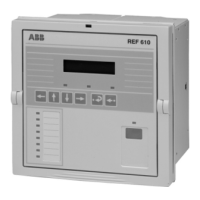111
503V18 Class 1 Event delay
503V19 Class 1 Event count
503V20 Class 2 Event delay
503V21 Class 2 Event count
503V22 Class 3 Event delay
503V23 Class 3 Event count
Example:
(class 1)
The events are reported when the event delay (SPA parameter 503V18) has
elapsed or the defined amount of events (SPA parameter 503V19) are
generated for class 1.
If send throttles are not wanted, the event delay should be set to 0 and the
event count to 1. In this case, the class events are sent to the host immediately
as they occur.
Event buffer overflow
DNP 3.0 event buffer overflow is indicated with the internal indication IIN2.3, as
defined by the standard. IIN2.3 can also indicate event buffer overflow in the
internal communication between the DNP3.0 module and the main CPU module of
the relay. In this case, the relay automatically activates and resets the IIN2.3 bit.
As events have been lost in both cases, the DNP 3.0 master should perform an
integrity scan after the IIN2.3 bit has been reset.
DNP counters and frozen counters
DNP counters in use have a corresponding frozen counter. The frozen counters in
object group 21 have the same DNP point index as the ordinary DNP counters.
Further, frozen counters can only be read as static objects, and frozen counter events
(object group 23) are not supported.
Collision avoidance and detection
The relay supports both collision avoidance and detection. Collision detection can
be enabled or disabled with SPA parameter 503V235. Collision avoidance occurs
before message transmission. When preparing to transmit and the link is busy, the
relay first waits until the link becomes idle. After this, a backoff time starts. When
the backoff time elapses, the relay checks the link again. If the link is not busy, the
relay starts the transmission. The backoff time is calculated as follows:
backoff time = silent interval + random delay
Feeder Protection Relay
Technical Reference Manual
REF 610REF 610
1MRS755310

